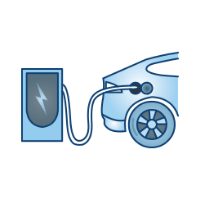Courses by Software
Courses by Semester
Courses by Domain
Tool-focused Courses
Machine learning
POPULAR COURSES
Success Stories
Week-11 Challenge: Braking
1. For a defined driving cycle, calculate the energy required for braking. DRIVING CYCLE: A driving cycle is typically represented by a series of data points which plots vehicle speed against time. Driving cycles are produced to assess the performance of vehicles in various ways, including fuel consumption and pollutant…
Swapnil Shinde
updated on 26 Nov 2022
1. For a defined driving cycle, calculate the energy required for braking.
DRIVING CYCLE:
A driving cycle is typically represented by a series of data points which plots vehicle speed against time. Driving cycles are produced to assess the performance of vehicles in various ways, including fuel consumption and pollutant emissions. There are different types of driving cycles depending upon different countries thier drivivng patterns, road conditions and climate conditions.
For an Electric Vehicle driving cycle is used to calculate the Range of Vehicle, Power Requirements, SOC of Battery, Energy Consumption in Wh/km and Vehicle efficiency.
Regenerative braking is an energy recovery mechanism that slows down a moving vehicle or object by converting its kinetic energy into a form that can be either used immediately or stored until needed. In this mechanism, the electric traction motor uses the vehicle's momentum to recover energy that would otherwise be lost to the brake discs as heat. This method contrasts with conventional braking systems. In those systems, the excess kinetic energy is converted to unwanted and wasted heat due to friction in the brakes, or with rheostatic brakes, where the energy is recovered by using electric motors as generators but is immediately dissipated as heat in resistors.

Law of Conservation of Energy tells that Energy can neither be created nor be destroyed but it can be transformed from one form to another, So in EV during Braking Kinetic Energy is being converted to electrical energy by using Traction Motor. But the kinetic energy which helps the vehicle to run also gets wasted while the braking is done. Though it depends on various parameters on how effective the braking would be it can be depended upon.
- Number of Brake Pistons
- Duration and Degree of Brake Pedal been Pressed
- Road Condition
- Temperature
- Brake Pad and Disc Condition
- Mass of the Vehicle
The Drive Cycle Selected is MIDC Part 2
_1669485113.png)
_1669485128.png)
The Braking happens at 111seconds to 119 seconds whe speed is reduced from 70kmph to 50kmph in 8 seconds and 2nd brake is applied at 358seconds to 380seconds where speed is reduced from 90kmph to 0kmph in 22seconds.
The Braking Power required in KW is 30.93KW and Energy Required for Braking in 400seconds is 0.135Kwh.
2. Why electric motor can’t develop braking torque at high speed similar to starting? How electric and mechanical brakes are coordinated?
Traction Motor has a characteristics that it can deliver highest torque at 0RPM. So Whenever the vehicle is at rest and to propel the vehicle Motor has to overcome the Tractive forces so it generates the Peak Torque during acceleration and whenever the motor reaches its Rated RPM or Critical Speed the Torque reduces since the RPM of Motor increases. At starting the motor draws a large current due Transient . As torque is proportional to square of current, therefore torque value is also high at this moment.

From Torque speed characteristic when speed increases torque should decrease to maintain power constant. At the time of starting speed is very low therefore Torque value is very high. At the time of braking, speed value is high therefore torque value will be low. Therefore at the time of braking torque value available will be lower. so braking torque is lower than acceleration torque
But During braking suppose the Vehicle is at 80kmphand the motor is running near to its peak RPM so the torque generated by motor will be less and to stop the vehicle from high speed the motor cannot generate higher torque due to its Speed-Torque characteristics.
So to stop the vehicle in less time Mechanical Brakes along with Regenerative Braking should be applied

The mechanical braking system powers the hand brake or emergency brake. It is the type of braking system in which the brake force applied on the brake pedal is carried to the final brake drum or disc rotor by the various mechanical linkages like cylindrical rods, fulcrums, springs etc. In order to stop the vehicle.
So to achieve better Braking Control 2 braking methods are used which increases the Braking Efficiency of Electric Vehicle
1. Series Braking:
In Series Braking Either Regenerative Braking or Mechanical Brakes are applied at a time
2. Parallel Braking:
In this the Regenerative Braking and the Mechanical Braking both are applied simultaneously.
But Regenarative braking efficiency is 12-20% ie only some amount of power can be sent back to battery because battery packs can discharge at double rate during acceleration but due to its chemistry charging rate is minimum.
When the brake pedal is pressed the hydraulic fluid reaches the brake piston and created the braking pressure on the wheels and the same kinetic energy is been used by the Regenerative Braking for generating more power using the Bi-directional motor which operates as a generator while braking.
NISSAN LEAF EDIB (ELECTRIC-DRIVEN INTELLIGENT BRAKING):
EDIB (Electric Driven Intelligent Brake) controls the regenerative brake and friction brake to support both of these requirements. Further, it also controls the reactive force from the pedal in order to unify the feeling when stepping down on the pedal and the sense of deceleration.
In Nissan Leaf Electric Driven Intelligent Brakes are used in which both Regenerative and Mechanical brakes are applied at higher speeds since the power required to stop the vehicle is higher and Regenerative Brakes and Mechanical Brakes individually cannot stop the vehicle in efficient way, but at lower speeds only Regenerative Brakes are applied since at lower speeds Motor has higher torque.


3. Make a MATLAB program which plots contour of given motor speed, torque and efficiency values. Attach the code as a .m file attach a screenshot of all the plots.
The motor efficiency ηm [-] is the ratio between output power Pout [W] and input power Pin [W]:

The input power is the summation of the output power and the power losses Ploss
The total Power Losses is sum of all the losses

where:
kc [-] – copper losses coefficient
ki [-] – iron losses coefficient
kw [-] – windage losses coefficient
C [W] – constant power losses
T [Nm] – motor torque
ω [rad/s] – motor speed
MATLAB CODE FOR PLOTTING THE CONTOUR OF MOTOR SPEED, TORQUE AND EFFICIENCY:
clc
clear
% Speed in (Rad/Sec)
w=linspace(0,1500);
% Torque in Nm
T= linspace(0,500);
% LOSS COEFFICIENTS
kc = 0.15; % COPPER LOSSES
ki =0.005; % IRON LOSSES
kw =0.000012; % WINDAGE LOSSES.
% MESHGRID
[X,Y]= meshgrid(w,T); %Converting to 2D
copper_loss =(Y.^2)*kc;
iron_loss= X*ki;
wiindage_loss= (X.^3)*kw;
cons = 20;
output_power =X.*Y; %Power = Speed*Torque
input_power = (copper_loss)+(iron_loss)+(wiindage_loss)+(output_power)+(cons);
Efficiency = (output_power)./(input_power);
V=[0.70,0.80,0.90,0.91,0.92,0.925,0.93]; %Efficiency to be plotted
box off
grid off
contourf(X,Y,Efficiency,V);
contourcbar
title('SPEED TORQUE CHARACTERISTICS OF MOTOR');
xlabel('Speed in rad/s');
ylabel('Torque in N/m');
_1669475607.png)
_1669475625.png)
Workspace Variables
_1669475652.png)
SPEED TORQUE CHARACTERISTICS OF MOTOR WITH EFFICIENCY
Explanation:
- First the Speed and Torque values are defined using the "linspace" command.
- Then the motor loss coefficients Copper loss, Iron loss and Windage losses are defined.
- Then Meshgrid command is used to create a grid of X and Y values which are speed and torque.
- Now Copper losses, Iron losses and Windage losses are calculated by using formula Kc*T^2, Ki*w and Kw*w^3.
- The output power which is product of Speed and torque is calculated.
- The Total losses and output power are added to get input power and Efficiency is calculated by ratio of output power to input power.
-
Pi=Pout+KcT^2+Ki*w+Kw*^3+Const
Using this formula, we calculate the efficiency and then contour is plotted
- Inabove Speed orque Characteristics the middle part in yellow colour indicates the highest efficiency which is above 94%.
- The orange part represents the Motor efficiency about 90%.
- The outermost part which is in dark blue colour represnts the motor efficiency in range of 70% to 75%.
Leave a comment
Thanks for choosing to leave a comment. Please keep in mind that all the comments are moderated as per our comment policy, and your email will not be published for privacy reasons. Please leave a personal & meaningful conversation.
Other comments...
Be the first to add a comment
Read more Projects by Swapnil Shinde (15)
Project 2 - Modeling of 3 phase Induction Motor Drive
AIM: The aim is to design the 3 Phase Inverter using Simulink with switching frequency of 10KHz and Controlling the 3 phase Squirrel Cage Induction motor, using V/F method from 3 Phase Inverter. Given Parameters: Power = 100 HP DC Voltage = 800 V Output Voltage = 460 VRMS – line to line Initial Speed = 1500 RPM Final…
17 Mar 2023 12:25 PM IST
Project 1 - Loss calculation for a DC/DC converter-MATLAB
Design of boost converter, and calculating the loss of different components including power switching device and deriving efficiency of boost converter. This is applicable in power supply industry, electric vehicles etc where DC-DC converter is required to boost the voltage from DC source. All the aspects of this project…
11 Mar 2023 01:21 PM IST
Project 2
AIM: Using MATLAB/simulink and the drive cycle from the attached excel sheet, find- The max heat generation of the battery The SOC of the battery at 2 *104second of the battery operation Time Time Step Battery Current 00:00.4 0.1 -0.9632 00:00.5 0.2 -0.952 00:00.6 0.3 -0.9072 00:00.7 0.4 -0.9632 00:00.8 0.5…
20 Jan 2023 02:45 PM IST
Project 1
1. Design a battery pack for a car roughly 150 Kw with 120 V. Use 3500 mAh 3.6V nominal NMC chemistry cell. A battery management system (BMS) is said to be the brain of a battery pack. The BMS is a set of electronics that monitors and manages all of the battery’s performance. Most importantly, it keeps…
19 Jan 2023 02:34 PM IST
Related Courses





Skill-Lync offers industry relevant advanced engineering courses for engineering students by partnering with industry experts.
Our Company
4th Floor, BLOCK-B, Velachery - Tambaram Main Rd, Ram Nagar South, Madipakkam, Chennai, Tamil Nadu 600042.
Top Individual Courses
Top PG Programs
Skill-Lync Plus
Trending Blogs
© 2025 Skill-Lync Inc. All Rights Reserved.









